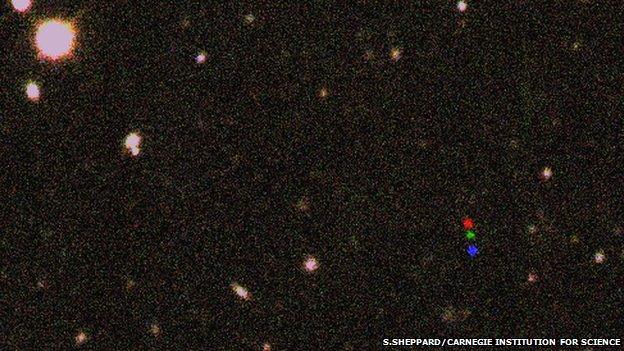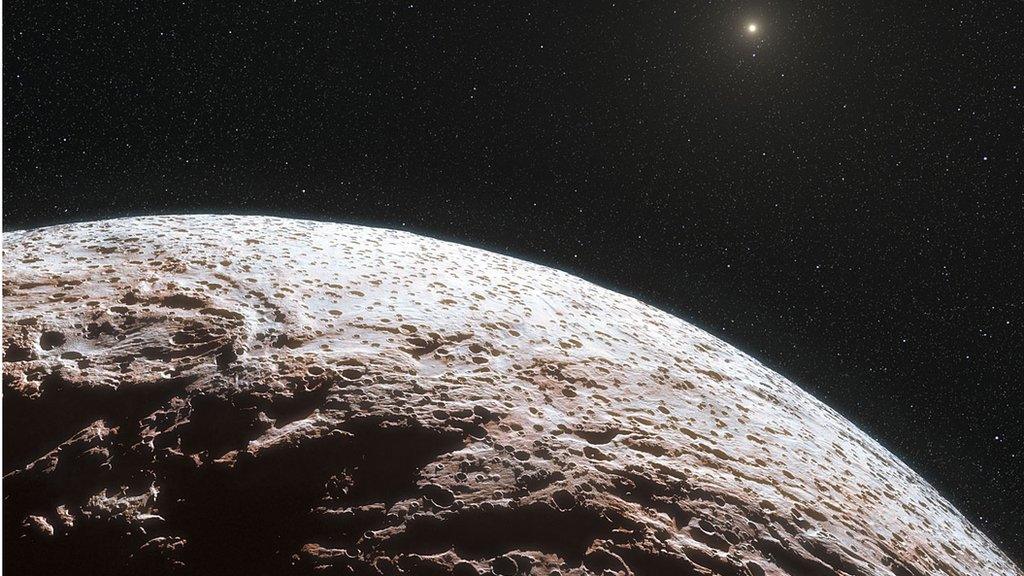Icy body found orbiting far from Sun
- Published

Three different images taken two hours apart and overlaid to reveal 2012 VP113's movement (coloured dots)
Scientists have identified a new dwarf planet in the distant reaches of our Solar System.
It is being called 2012 VP113 for the time being, is about 450km across and is very likely icy in composition.
To date, only one other such object has been seen orbiting beyond the major planets in its region of space referred to as the inner Oort Cloud.
That previous object, called Sedna, is about 1,000km across, and was found 10 years ago.
But researchers believe there are hundreds more such objects awaiting detection.
"We've been using a large camera on a four-metre telescope in Chile, and it's a very powerful facility," said Scott Sheppard from the Carnegie Institution of Science in Washington DC, US.
"Our survey covered just a very small area of the sky - about 220 full Moons of sky. So, there's a lot more sky out there, and we predict, based on this one object, that across the whole sky we could expect to find 900 objects of 1,000km or bigger in size.
"Some of these could be bigger than Pluto; some could even be bigger than Mars or the Earth. The problem is they're just so distant, especially when they're in the far parts of their orbits, that they're just too faint to detect," he told BBC News.
The observations of 2012 VP113 are reported in the journal Nature, external. They indicate that the object gets no closer than about 12 billion kilometres to the Sun, and at the farthest point in its eccentric orbit is a staggering 67 billion km from our star.
To put that in some context, the Earth is 149 million km from the Sun, and even the most distant major planet - Neptune - seems close at 4.5 billion km, by these standards.
Sheppard and his colleague Chad Trujillo, from the Gemini Observatory in Hawaii, have calculated that 2012 VP113 takes 4,000 years to go around the Sun.
The big question is: how did it and Sedna come to be where they are?
'Reddish colour'
Astronomers have made great progress in mapping the close-in parts of the Solar System.
Even surveys in the region just beyond Neptune referred to as the Kuiper Belt have thrown up many hundreds of detections, some of which rival the zone's best known inhabitant - Pluto.
But it is the Oort Cloud - the region even further out - that has proven very difficult to study.
Models for Solar System formation suggest that it is highly unlikely 2012 VP113 was created in its present location. Its orbit is just too eccentric.
One explanation is that it was perturbed gravitationally and pulled out of the Kuiper Belt by a passing planet that was expelled from our Solar System early in its history. Another idea is that it was pulled out of the Kuiper Belt by a star passing very close by in our part of the galaxy. A third, tantalising possibility is that it is actually an object stolen from a star that formed from the same "nursery" of gas and dust as our Sun billions of years ago.
Additional detections would help narrow possibilities.
In the meantime, more precise information on 2012 VP113's orbit is being sought. Astronomy's nomenclature authority, the International Astronomical Union, requires such data before it will sanction a catchier name.
"Based on 2012 VP113's reddish colour and what we know about other objects in the Solar System, and where this object is, we believe it's probably made mostly of water-ice, and probably some methane ice and carbon dioxide ice, with a little rock thrown in. And it's so cold that the ice would be harder than the rock on Earth," explained Dr Sheppard.
"If you could stand on the object and look towards the Sun, you'd be so far away it would look little more than just a bright star in the sky."

This diagram gives a sense of the huge orbits of some objects
The Sun and inner planets are at the centre and too small to see
Jupiter, Saturn, Uranus and Neptune are shown by purple solid circles
Pluto is in a region of space called the Kuiper Belt, shown in light blue
Sedna's orbit is shown in orange; 2012 VP113's orbit is shown in red
Jonathan.Amos-INTERNET@bbc.co.uk and follow me on Twitter: @BBCAmos, external
- Published21 November 2012
